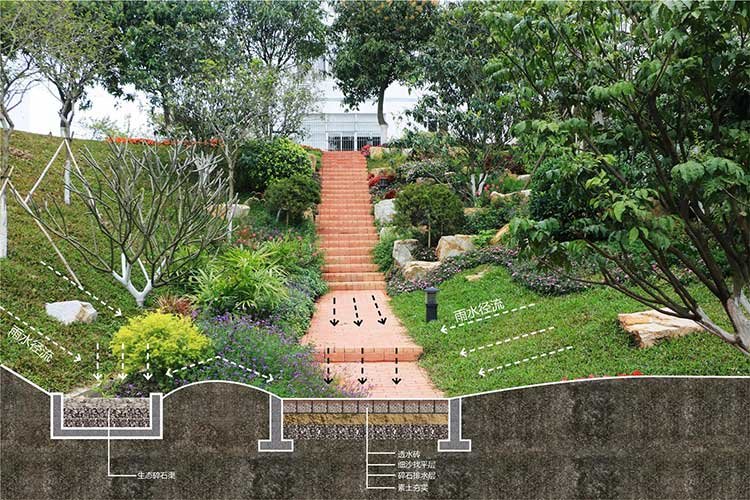المدينة الإسفنجية هي جيل جديد من مفهوم إدارة مياه الأمطار في المناطق الحضرية، وهو ما يعني أن المدينة يمكن أن تتكيف مع التغيرات البيئية وتستجيب للكوارث الطبيعية التي تسببها مياه الأمطار مثل الإسفنج، وتتمتع بمرونة جيدة. ويمكن أن يطلق عليها أيضًا اسم "المدينة المرنة للمياه".
مثل الإسفنج، يمكن للمدينة أن تتكيف مع التغيرات البيئية وتستجيب للكوارث الطبيعية بـ "مرونة" جيدة. والمصطلح العام الدولي هو "بناء نظام مياه الأمطار منخفض التأثير الإنمائي". عندما تهطل الأمطار، تمتص المياه وتخزن المياه وتتسرب المياه وتنقي المياه. عند الحاجة، يتم إطلاق المياه المخزنة واستخدامها لتحقيق الهجرة الحرة لمياه الأمطار في المدينة.
وانطلاقًا من خدمة النظام الإيكولوجي، فإن بناء البنية التحتية الإيكولوجية للمياه عبر النطاقات وبناء البنية التحتية الإيكولوجية للمياه بالاقتران مع تقنيات محددة متعددة هي جوهر المدينة الإسفنجية.
يشير تجميع مياه الأمطار إلى تجميع واستخدام الجريان السطحي للأمطار التي يتم تجميعها من الأسطح الصلبة مثل أسطح المباني والطرق والساحات. يتم تجميع مياه الأمطار من خلال قنوات مثل التجميع - نقل المياه - تنقية المياه - التخزين، ويتم تجميعها لتوفير تجديد مياه الأمطار للتخضير والمسطحات المائية للمسطحات الخضراء ومصادر المياه الجوفية والغسيل والمياه الجوفية، وذلك لتحقيق الغرض من الاستفادة الشاملة من موارد مياه الأمطار والحفاظ على المياه.
نظام تجميع مياه الأمطار والاستفادة منها
ما هي استخدامات مياه الأمطار المجمعة؟
ويمكن استخدامه لغسل المراحيض ورش الطرقات وري المروج وتجديد المياه للمساحات المائية، بل ويمكن استخدامه كمياه تبريد متداولة ومياه لمكافحة الحرائق. ويمكنها أن تخفف بشكل فعال من الوضع الحالي المتوتر لنقص المياه في المناطق الحضرية وهي وسيلة فعالة لزيادة الإيرادات وتوفير النفقات.
يمكن أن تتسرب مياه الأمطار من خلال مواد الرصف القابلة للنفاذ والمساحات الخضراء لتجديد موارد المياه الجوفية وتحسين البيئة الإيكولوجية وتجديد موارد المياه العذبة بشكل فعال.
عندما يتجاوز هطول الأمطار حجم التصريف الحضري، تُستخدم وحدة تجميع مياه الأمطار لتخزين مياه الأمطار لتقليل ضغط الصرف الحضري والتحكم في الفيضانات، وبالتالي تحسين استقرار وموثوقية نظام تصريف الفيضانات الحضرية والحد من الفيضانات الحضرية.
مزايا أنظمة حصاد مياه الأمطار
1- يمكن أن توفر 501 تيرابايت 3 تيرابايت من مياه الشرب، ويمكن استخدام مياه الأمطار لغسل المراحيض وغسل الملابس والتنظيف وغيرها من الأغراض غير المتعلقة بالشرب;
اقتصادية: يمكن أن توفر تكاليف كبيرة;
2- حماية البيئة: يحمي موارد المياه الطبيعية، ويمكن لمياه الأمطار "الناعمة" أن تقلل من استخدام عوامل إزالة الترسبات;
3- تدفقات أقل لمياه الأمطار إلى محطات معالجة مياه الصرف الصحي، واستهلاك أقل للطاقة واستخدام المواد الكيميائية;
4- قشور أقل: مياه الأمطار هي مياه ناعمة، لذلك يقل تراكم الترسبات الكلسية في الغسالات ومراحيض التنظيف.
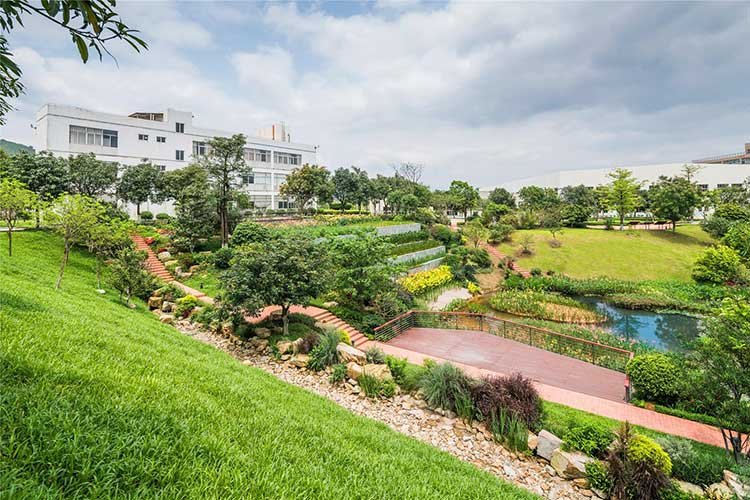
خزان تجميع مياه الأمطار
حوض تجميع مياه الأمطار هو منتج مخصص لأنظمة تجميع مياه الأمطار واستخدامها وبناء المدن الإسفنجية. إنه مصنوع من مادة البولي بروبيلين (PP) ويتميز بخصائص كونه خفيف الوزن وقوي ومقاوم للتآكل وغير سام وعديم الرائحة. يمكّن التصميم الهيكلي الخاص لحوض تجميع مياه الأمطار من تجميع مياه الأمطار وتخزينها بكفاءة، ويمكن استخدامها للري والتنظيف والتنظيف والتطبيقات الأخرى من خلال وصلات الأنابيب. يتميز حوض تجميع مياه الأمطار بسعة مساحة كبيرة ويمكن دمجه بمرونة وفقًا للاحتياجات الفعلية، وهو مناسب لمختلف البيئات الجغرافية والأماكن.
ميزات وحدة PP:
1) المعايير الفنية الرئيسية
1000 مم (طول) * 500 مم (عرض) * 500 مم (ارتفاع)
2) تصميم مرن للمنتج، يتألف من عدة وحدات لتكوين مجموعة,
يمكن الجمع بين شكل حوض السباحة بشكل اعتباطي وفقًا للاحتياجات، وليس مقيدًا بالموقع.
3) عمر خدمة طويل، الوحدة مصنوعة من مادة PP المعاد تدويرها، والمادة متينة ومقاومة للشيخوخة ودرجات الحرارة العالية ودرجات الحرارة المنخفضة، ويمكنها التكيف مع مختلف الظروف القاسية
البيئات.
4) البناء البسيط، باستخدام الربط بالوحدات النمطية، لا يتطلب آلات كبيرة.
5) النقل المريح، باستخدام التصميم المنفصل، يمكن تفكيك الوحدة حسب الرغبة، مما يوفر مساحة النقل.
6) فترة بناء قصيرة، يتم تجميع الوحدة في صندوق في موقع البناء، آمنة وسريعة. تقصير فترة البناء إلى حد كبير، يمكن أن يحقق التركيب والردم في نفس اليوم.
7) صديقة للبيئة وصديقة للبيئة، وحدة تجميع مياه الأمطار مصنوعة من مواد متجددة وصديقة للبيئة، مدفونة في أعماق الأرض دون تدمير البيئة البيئية بأكملها,
سهلة الصيانة، وقابلة لإعادة التدوير.
8) ميزة التكلفة رائعة. بالمقارنة مع صهاريج تخزين المياه التقليدية، فإن وحدات مياه الأمطار تقلل من تكاليف الوقت وتكاليف العمالة وتكاليف النقل وتكاليف الصيانة والتشغيل اللاحقة في العديد من الجوانب.
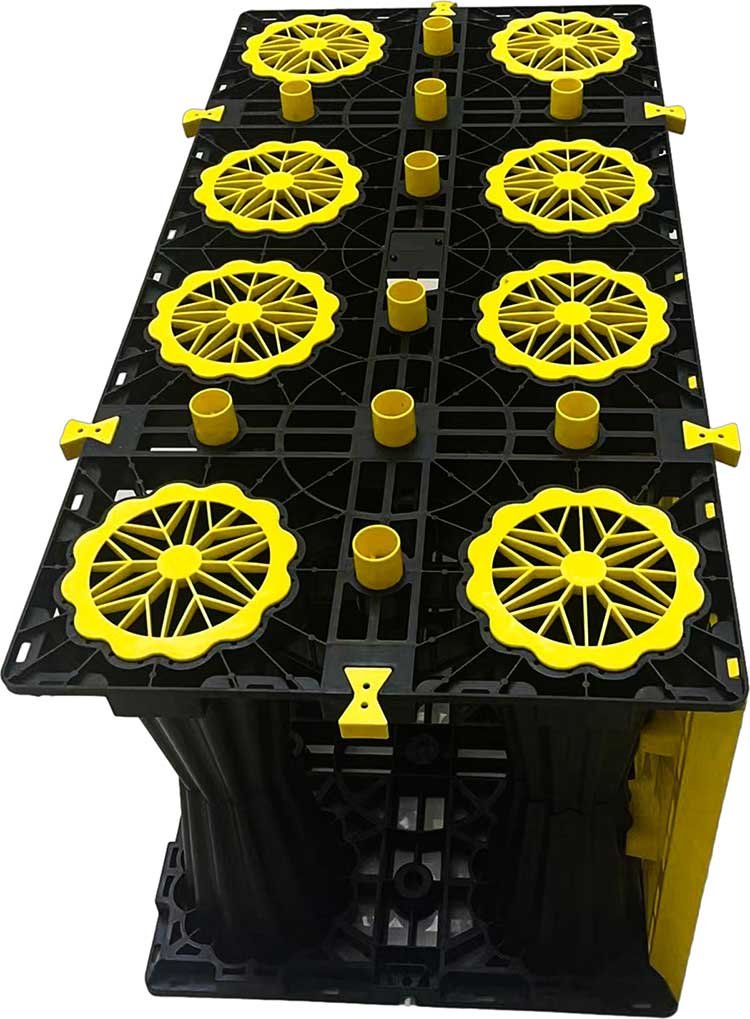
غشاء أرضي من البولي إيثيلين عالي الكثافة HDPE
خصائص أداء الغشاء الأرضي المصنوع من البولي إيثيلين عالي الكثافة
1) المعايير الفنية الرئيسية
1000 مم (طول) * 500 مم (عرض) * 500 مم (ارتفاع)
2) تصميم مرن للمنتج، يتألف من عدة وحدات لتكوين مجموعة,
يمكن الجمع بين شكل حوض السباحة بشكل اعتباطي وفقًا للاحتياجات، وليس مقيدًا بالموقع.
3) عمر خدمة طويل، الوحدة مصنوعة من مادة PP المعاد تدويرها، والمادة متينة ومقاومة للشيخوخة ودرجات الحرارة العالية ودرجات الحرارة المنخفضة، ويمكنها التكيف مع مختلف الظروف القاسية
البيئات.
4) البناء البسيط، باستخدام الربط بالوحدات النمطية، لا يتطلب آلات كبيرة.
5) النقل المريح، باستخدام التصميم المنفصل، يمكن تفكيك الوحدة حسب الرغبة، مما يوفر مساحة النقل.
6) فترة بناء قصيرة، يتم تجميع الوحدة في صندوق في موقع البناء، آمنة وسريعة. تقصير فترة البناء إلى حد كبير، يمكن أن يحقق التركيب والردم في نفس اليوم.
7) صديقة للبيئة وصديقة للبيئة، وحدة تجميع مياه الأمطار مصنوعة من مواد متجددة وصديقة للبيئة، مدفونة في أعماق الأرض دون تدمير البيئة البيئية بأكملها,
سهلة الصيانة، وقابلة لإعادة التدوير.
8) ميزة التكلفة رائعة. بالمقارنة مع صهاريج تخزين المياه التقليدية، فإن وحدات مياه الأمطار تقلل من تكاليف الوقت وتكاليف العمالة وتكاليف النقل وتكاليف الصيانة والتشغيل اللاحقة في العديد من الجوانب.
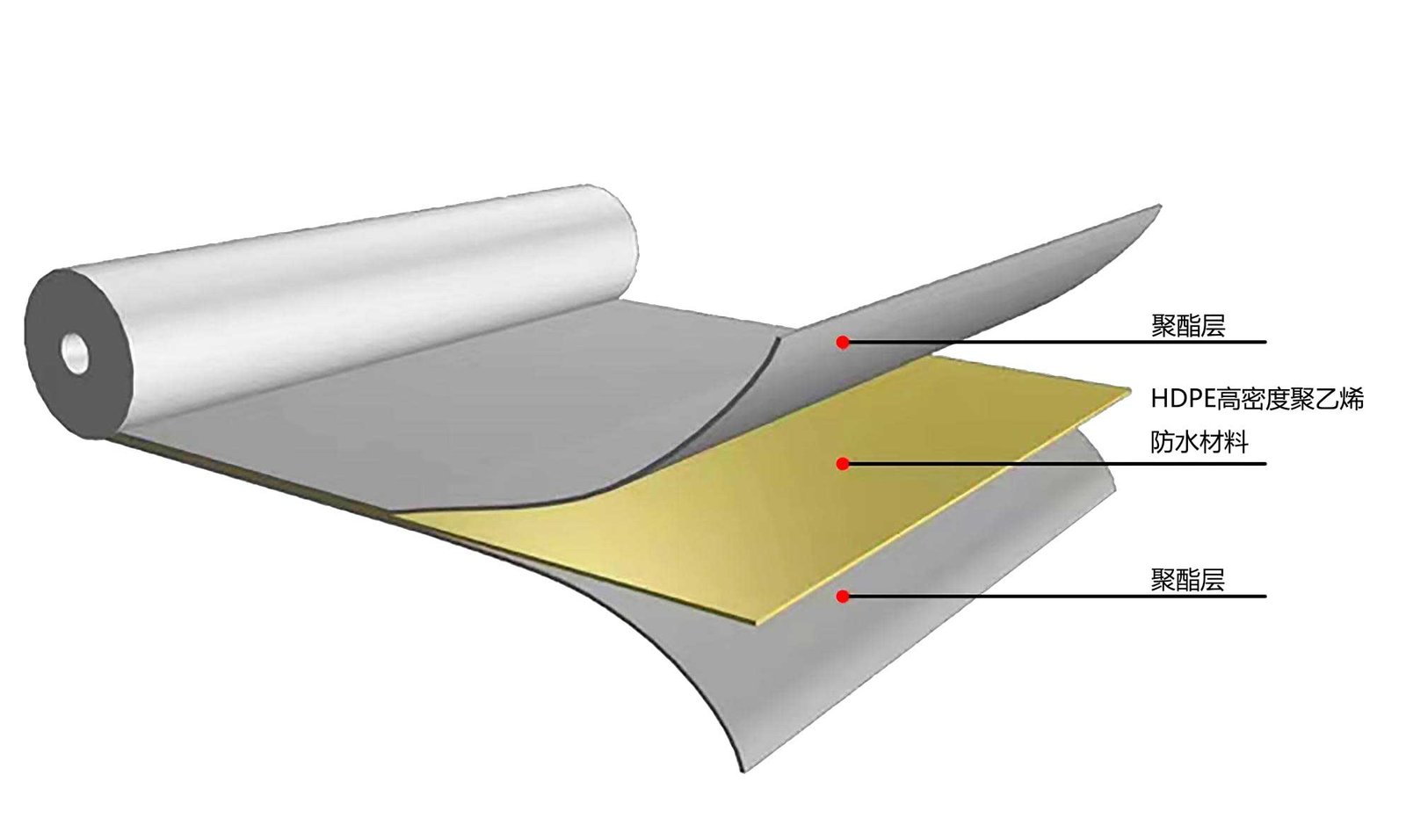
خصائص أداء الغشاء الأرضي المصنوع من البولي إيثيلين عالي الكثافة
1- لا تحتوي على إضافات كيميائية ولا تتم معالجتها بالحرارة، لذا فهي مادة بناء صديقة للبيئة;
2- تتميز بخصائص ميكانيكية جيدة، ونفاذية مياه جيدة، ويمكنها مقاومة التآكل والشيخوخة;
3- تتميز بمقاومة قوية ضد الدفن والتآكل، وهيكلها رقيق، مع أداء تصريف جيد;
4-يتميز بمعامل احتكاك جيد وقوة شد، ويتمتع بأداء تقوية جيوتقنية جيوتقنية;
5- تتميز بوظائف العزل، ومكافحة الترشيح، والصرف، والحماية، والثبات، والتعزيز;
6- يمكن أن تتكيف مع القواعد غير المستوية، وتقاوم تلف القوة الخارجية أثناء البناء، ولها زحف صغير;
7- تتميز باستمرارية جيدة بشكل عام، وخفة الوزن، وبنية مريحة;
8-إنها مادة قابلة للاختراق، لذا فهي تتمتع بوظائف جيدة مضادة للترشيح والعزل، وقدرة قوية مضادة للثقب، لذا فهي تتمتع بأداء حماية جيد.
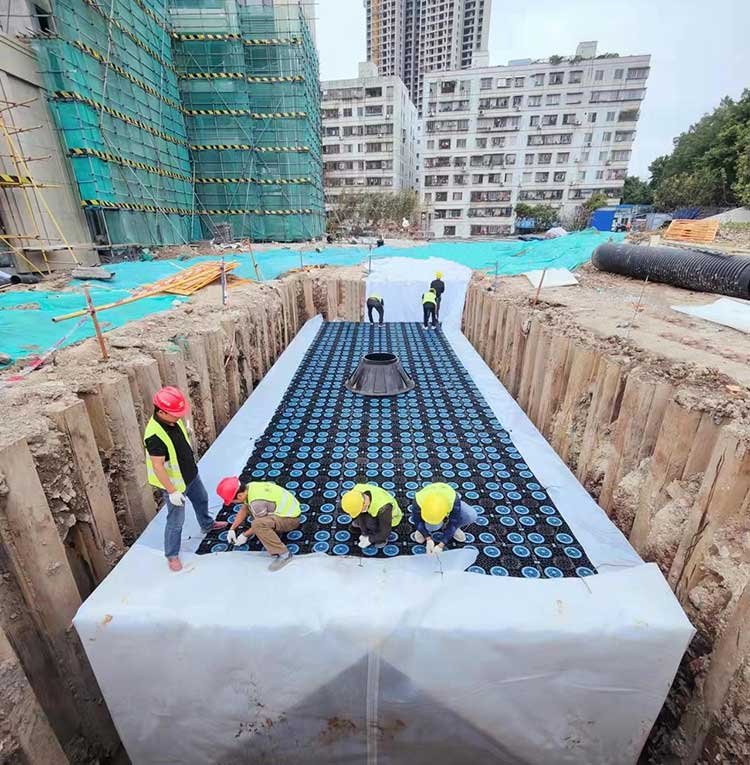
خطة بناء المدينة الإسفنجية الذكية
- استخدام واسع النطاق للأرض الطبيعية
يجب أن تتجنب المدن الإسفنجية الرصف الصلب على نطاق واسع، ولكن يجب أن تستخدم كمية كبيرة من الأرض الطبيعية، مثل زراعة المروج والمنحدرات
الجدران شديدة الانحدار وغيرها من التضاريس لتقليل سرعة تدفق المياه وتوجيه المياه السطحية للتسلل إلى الأرض، وزيادة مستوى المياه الجوفية الطبيعية. - نظام المساحات الخضراء متعدد المستويات والوظائف
يتم إنشاء نظام متعدد المستويات ومتعدد الوظائف للمساحات الخضراء في المدينة، مثل الحدائق البيئية المائية، وفجوات الشوارع، والأسطح الخضراء، وما إلى ذلك.
وفي الوقت نفسه، يتم تجميع مياه الأمطار ومعالجتها لتلبية احتياجات التخضير في المناطق الحضرية. - بناء حدائق الأمطار وأسواق مياه الأمطار
إنشاء حدائق أمطار وأسواق لمياه الأمطار في المدينة، ومن خلال طرق مثل جمع مياه الأمطار وتصفيتها وتنقيتها وتخزينها وتوزيعها,
تحقيق تنقية مياه الأمطار في المناطق الحضرية وإعادة تدويرها.
وباختصار، فإن المدن الذكية والمدن الإسفنجية هي اتجاه البناء الحضري المستقبلي الذي يتطلب جهودًا مشتركة بين الحكومة والمؤسسات وجميع قطاعات المجتمع
للترويج. ولن يتسنى خلق بيئة حضرية أكثر ملاءمة للعيش وصحية وصديقة للبيئة إلا من خلال بناء المدن الذكية والمدن الإسفنجية وتعزيز التنمية المستدامة للمدن.
منشآت بناء المدن الإسفنجية: مداخل مياه الأمطار الصديقة للبيئة، وقنوات التسرب، وأحواض تجميع مياه الأمطار، والأرصفة القابلة للنفاذية، والأسطح الخضراء، ومرافق الاحتباس الحيوي، ومرافق الاحتباس الحيوي، والمساحات الخضراء الغارقة، وبرك التسرب، وآبار التسرب، وأنابيب التسرب، والبرك الرطبة، والأراضي الرطبة لمياه الأمطار، والخزانات، وخزانات مياه الأمطار، وبرك تنظيم مياه الأمطار، وأحواض تنظيم مياه الأمطار، وأحواض تنظيم مياه الأمطار، وأحواض تنظيم مياه الأمطار، والخنادق المزروعة بالأعشاب، والمناطق العازلة للنباتات، ومرافق تصريف مياه الأمطار الأولية، والتسلل الاصطناعي للتربة، وتشمل أيضًا جميع شبكات أنابيب مياه الأمطار، ومحطات ضخ مياه الأمطار، إلخ.
